With over 4000 species of lizards, finding the best one to keep as a pet will determine the level of care you are going to deal with. Leopard geckos and bearded dragons are among the most popular pet reptiles and have been regarded by many as the perfect reptile to keep as pets. Both are cute, and their fascinating behavior makes them more lovable.
However, the two reptiles have significant differences when it comes to care, habits, activity levels, etc. If you are undecided about which one to pick as a pet, this post will help you decide. Which is more suitable for you? Let’s get into the key differences.
Bearded Dragon vs Leopard Geckos – Differences
| Bearded Dragon | Leopard Gecko | |
| Adult length | 16 – 24 Inches | 7 – 10 Inches |
| Adult weight | 250 – 850 grams | 40 – 65 grams ounces |
| Lifespan | Up to 15 years | Up to 20 years |
| Tank Size | 50 – 75 gallons for each adult. | At least 20 gallons for each adult |
| Tank needs | Paper substrate or reptile carpets are safe. | Reptile carpet, linoleum, tile, calcium, or slate sand can be used. Climbing rocks and other enrichment objects |
| Lighting, Heating, and Humidity Requirements | Full-spectrum light and heat sources. | Normal indoor light enough and safe heat source with 2 – 3 hides. |
| Skincare requirements | Misting severally at daytime; which increases during shedding | Humidity within the enclosure and a small container to loosen shed. |
| Beginner Friendly | Yes | Yes |
| Other pet friendly | Keep away from other pets | keep safe from other pets that may hurt them. |
| Temperament | Enjoys being handled and loves to bond | docile but excessive handling could cause stress |
| Expenses (Food) | $5- 30 per week | $10 per week. |
| Diet | Omnivores that can eat live food and leafy greens. Freeze-dried food, veggies, and fruits are necessary. They may also need calcium supplementation. | carnivorous thriving on live insects, e.g., mealworms, super worms, flies, roaches. Calcium supplements may be needed |
Lifespan
Both these lizards are known to have relatively long life expectancies. The Royal Society for the Prevention of Cruelty to Animals estimates the lifespan of a bearded dragon to be between 10 to 15 years. In some cases, pet beardies have been known to live longer than that. It’s also not uncommon for a bearded dragon to live for 20 years.
On the other hand, a leopard gecko has an average lifespan of 15 to 20 years. Some owners say they could live for as long as 28 years, albeit on rare occurrences.
Even with the best care, your gecko is still not destined to live for two decades. There are some aspects affecting the lifespan of a lizard, some out of your control. For instance, if the pet lizard is genetically predisposed to illness, you might lose them earlier.
As the owner, you need to offer proper care to your pet lizard for a happy and potentially long life possible.
Verdict: both the leopard gecko and bearded dragon have a similar lifespan, but the leopard geckos may be able to live longer with proper care.
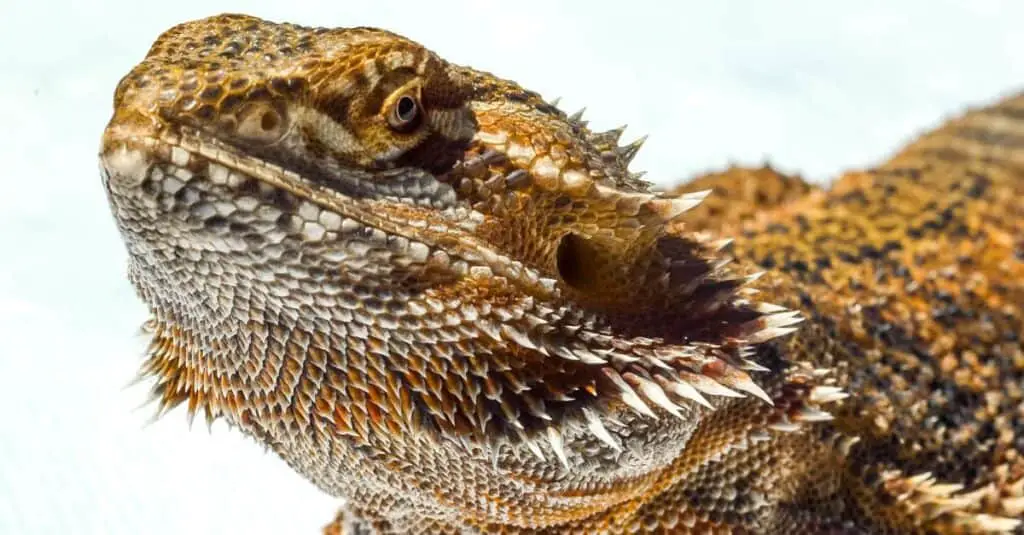
Size and Weight
A bearded dragon is medium-sized and will reach between 17 -24 inches long, but the German giant bearded dragons can reach 24 inches. Keep in mind that some bearded dragons could be dwarf, achieving just 10 to 14 inches. A baby bearded dragon measures about 4 inches and should grow to maturity in 2 years.
On the other hand, Leopard geckos are much smaller, reaching about 10 inches at maturity. A newborn leopard gecko, on the other hand, is approximately 5 inches, slightly bigger than a bearded dragon’s hatchling.
Regarding weight, adult leopard geckos could weigh 45 to 65 grams but could be more. Males are usually larger than females. Adult beardies weigh up to 850 grams and are as light as 250 grams.
Verdict: Bearded dragons are visibly bigger than Leos unless it’s dwarf bearded dragons. Bearded dragons are easier to handle than leopard geckos. The latter can be more fragile to handle for the inexperienced and children.
Looks
Bearded dragons are similar to small dragons with a bearded that they puff up when they feel threatened. There are different beardie morphs, including gold, white, red, yellow, striped, etc. The leopard geckos, on the other hand, have unique movable eyelids that distinguish them from others.
Other Gecko species have a visible membrane to protect the eyes. They also have a thick tail, soft belly, broad head, and bumpy skin on the top.
Like beardies, there are various leopard gecko morphs in multiple colors and patterns. Common Leopard Geckos include carrot-tailed, blizzard, supergiant, tangerine leopard geckos, etc.
Verdict: Which pet to choose depends on your personal preferences because both are attractive. For me, the Leos have that distinctive look with a leopard-like look, which makes them more beautiful.
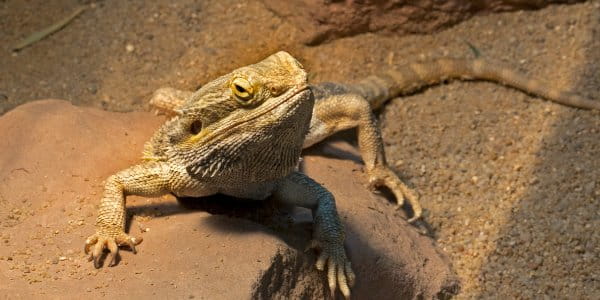
The Active Time of Day
Bearded dragons are diurnal, which means they stay active in the day and sleep at night. They can be an excellent pet for a home with kids or if you don’t stay up at night.
Leopard Geckos, on the other hand, are crepuscular, meaning they stay primarily active during twilight. In other words, you can get a better view of your leopard gecko when the sun goes down in the evening and very early in the morning before it rises again.
Verdict: Your choice here depends on your lifestyle and your availability. Owners who are active at night can train the dragon to sleep during the day. You just need to keep their room dark in the day and put on the lights at night, but this is not recommended.
Diet
Bearded dragons are omnivorous, meaning they can feed on both insects and plant-based foods. Juveniles need more live insects, while adults will prefer primarily vegetables.
Young bearded dragons should eat at least three times a day, while adults should feed not more than twice daily. Bearded dragons could survive a few weeks without food if required.
Geckos are exclusively insectivorous and prefer to eat live food primarily. However, you can allow them to enjoy freeze dried insects, but live insects should be the main. Although they can eat a wide range of insects, be ready to spend a little more money because insects are generally expensive.
Also, Geckos need to feed at least once in two days, but babies must eat every day until they reach 18 months. The lizards could go for up to a week with no food.
Verdict: Geckos prefer to eat live insects, so you have to factor in the cost of live foods. Bearded dragons, on the other hand, eat greens after reaching maturity. However, bearded dragons eat quite a lot while adult leopard geckos eat once every other day.
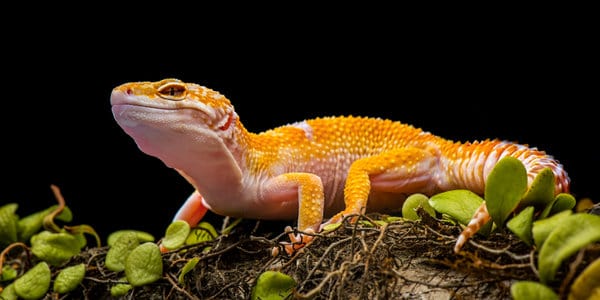
Brumation
Bearded dragons will start brumating at the age of 12-18 months. The beardies will start bromating in winter when they can no longer bear the low temperatures.
However, not all bearded dragons brumate. When they do, it can last from a few weeks to 2-3 months. Some can brumate longer than that. Unlike other reptiles, bearded dragons do not lose weight at all during brumation.
Leopard Geckos hardly brumate in captivity as long as the temperature and lights are constant. Some will, though, regardless of the setup. During the process, leopard geckos become lethargic, their appetite drops, and they may spend most of the wintertime asleep.
Experienced owners may induce brumation with the intent to breed leopard geckos. The dormant phase in leopard geckos can last for a few weeks to months.
Most will lose at least 5 grams or more of the process during brumation. The loss of weight results from their poor eating during the period.
Verdict: Leopard Geckos are less likely to brumate unless it’s induced. Bearded dragons are likely to experience it for a few weeks to months without losing any weight at all.
Personality
Bearded dragons are truly amusing pets. They have unique curiosity, love spending time with the owner, and quickly bond and sit on their owner’s shoulder. You can even take your bearded dragon outside with you. The lizards are genuinely a joy to watch, and their docile personality is impressive.
Leopard Geckos have unique personalities, can easily bond, and are fun to watch. Most leopard geckos are docile, but sometimes they don’t like handling. Albeit active, the geckos are shy, but you could still have various activities outside during summer.
Verdict: Both the bearded dragons and leopard geckos are easy to bond with and socialize with. That does not sum up their personality, though, as some will be more interested in contact with the owner than others.
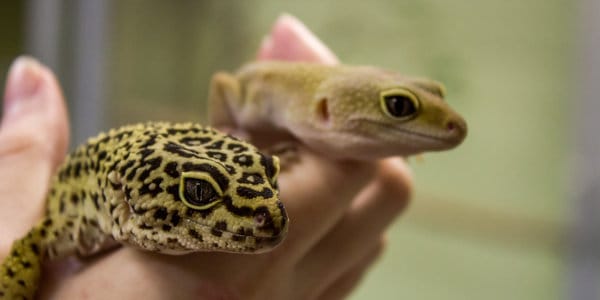
Tank Size and Considerations
Bearded dragons are desert-dwelling reptiles that prefer arid and dry climates with some moisture for sheds. Baby bearded dragons can live in a 15-gallon tank for the first two months.
An adult bearded dragon will require 55-70 gallons of space, and the tank should be at least 36 inches long. A 40-gallon breeder tank is a minimum requirement, so you should aim for bigger.
Glass and acrylic tanks are preferred to allow the owner to watch the bearded dragon. Some owners prefer to have wood enclosures for insulation.
However, they can be heavy and will require an experienced carpenter to build in a way you can view the pet. PVC is also emerging as more preferable than wood because it’s lighter and more manageable.
As cold-blooded creatures, beardies also require a heat source to regulate the temperature. Heating mats, rocks, and pads are not recommended due to the risk of overheating and burning the belly of your beardie.
The pet should always have access to a water dish. A food bowl is also great to reduce food messes live insects escaping.
Even though bearded dragons thrive in the desert, you should not give them sand as a substrate. The reason is they could accidentally swallow sands, which could result in intestinal impactions, which is a common occurrence for juveniles. Use newspaper or reptile carpeting instead.
A leopard gecko, on the other hand, requires at least a 20-gallon wide terrarium, but young ones can do fine with a 10–15-gallon tank. For adults, 20 gallons is the bare minimum, but 30 gallons should help to create a stimulating environment.
An essential aspect of a leopard gecko tank is they need a hotter side with a warming mat and a cooler side with some damp material to cool off.
Like the beardies, leopard geckos should not have sand as a substrate as they might accidentally consume it.
While a reptile carpet can do the job, it’s best to look for tile, linoleum, or slate as these can easily be cleaned, maintain the heat, and absorb excess humidity. You need to offer a shallow bowl of water and a separate one for insects.
Since they are nocturnal, they prefer to live in an environment with hidden areas like caves and logs. They require specific tank lighting to keep the day/night cycle better for them.
Verdict: Both the leopard gecko and bearded dragon need horizontal tanks (not vertical). However, leopard geckos require less space than bearded dragons. Both require heating and a lighting source.
Lighting, Heating, and Humidity Requirements
Bearded dragons are cold-blooded and need a constant basking spot with at least 70F and not more than 100F. In addition, they need a high output UVB that heats at least 50% of the tank and up to 90%. Make sure to replace the UVB after every six months to maintain efficiency. The heat aids in the quicker absorption of food.
Leopard Geckos do not have specific heat and light requirements. They just need a room with warmth, and you don’t have to provide skin heating unless it’s winter.
Still, a basking spot is crucial and should have temperatures between 83 to 90 degrees Fahrenheit. You don’t need to buy a heat lamp or UVB lamp – even a low 5.0 UVB bulb should suffice. You can provide an under-tank heater and a heat cable as they might require heat on their belly to digest food.
Verdict: Leopard geckos have less heating and lighting requirements than bearded dragons. They just need a warm tank to stay warm and digest food. Bearded dragons have high heating and lighting requirements and UVB bulbs to remain healthy. Both need humidity as low as 30%.
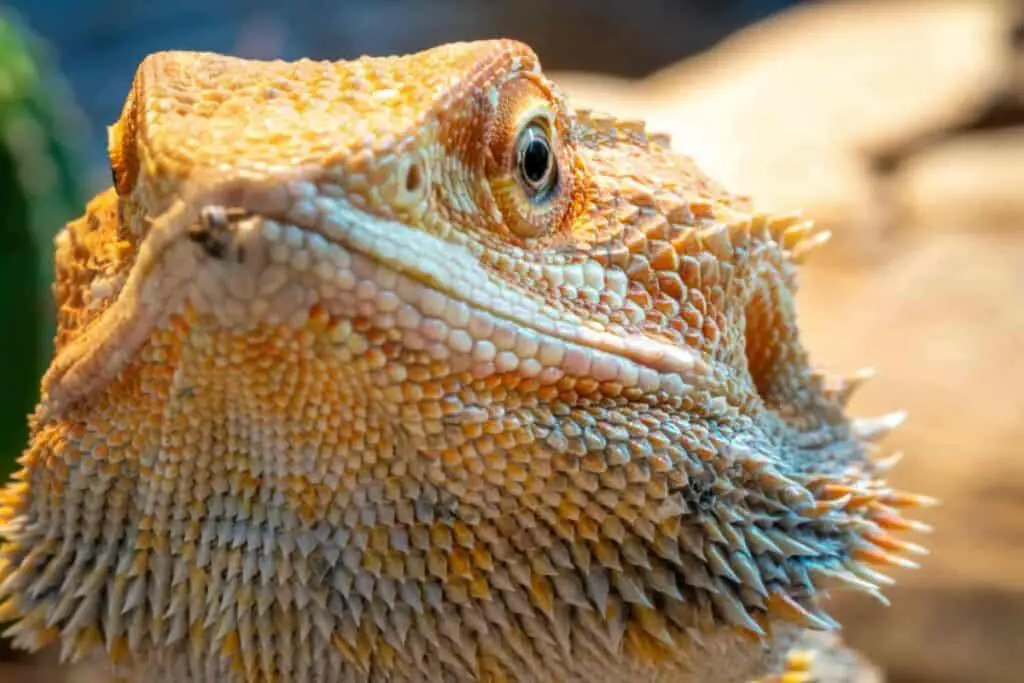
Health
Bearded dragons are reasonably hardy reptiles put in the wild, and if well looked after with a proper diet, they can remain healthy for long in captivity. However, raising them in a dirty environment and on an improper diet with high phosphorus and low calcium or vitamin D will lead to metabolic bone disease (MBD).
- MBD symptoms include softening of the facial bones and swelling of the lower jaw. Tremors on the legs as the dragon tries to walk and a low crouch can also indicate the presence of the disease.
- Bacterial infections in the gums cause infectious mouth rot. They are easily identified via the presence of gum swelling and thick mucus with a cottage cheese consistency in the mouth.
- Respiratory infections occur in bearded dragons kept in dirty conditions with cold temperatures and an improper diet. They are primarily caused by fungal, viral, or bacterial infections. Symptoms include sneezing, shallow breathing, decreased appetite, lethargy, and discharge from the eyes or nose.
- Adenovirus is extremely common in young bearded dragons and leads to gastrointestinal infections and fatal hepatitis. Symptoms include loss of appetite, weak and paralyzed limbs, ultimately, may die.
- Parasites can infect pet bearded dragons’ intestinal tracts, spreading to other organs. Common parasites include pinworms which cause weight loss and diarrhea. Skin ticks and mites can inhabit between the scales and around the lizard’s skin folds.
On the other hand, Leopard geckos are hardy, but they can suffer from broken bones, tail dropping, and constipation if left in dirty conditions and fed on an improper diet without access to sunshine or UVB light.
- Cryptosporidium is common in leopard geckos, leading to small intestinal epithelial hypertrophy. Symptoms include diarrhea, stunted growth, rapid weight loss, and dark spots in the poop.
- Dysecdysis is the failure to shed skin that affects young leopard geckos during their rapid growth phases. Symptoms include retention of old skin on the toes, which causes constriction and loss of toes if left untreated. It can also affect the eyes leading to bacterial and fungal infections and conjunctivitis.
- Autotomy is the autoamputation of leopard gecko tails when threatened. When scared, the gecko will cleave off its tail via intensive muscular contraction, and the dropped tail continues to twitch as a distraction to any predators, which gives the gecko room to escape. In captivity, roughly handling a leopard gecko, particularly the tail, will cause autonomy, and the remaining stump can bleed before the open wound seals up.
- Egg Binding is common among female leopard geckos due to a lack of appropriate nesting sites or calcium deficiency. Symptoms include indiscriminate digging, distended coelom, and lethargy.
Verdict: both bearded dragons and leopard geckos are hardy pet reptiles and can have a long healthy life when kept in [proper conditions and fed on a healthy diet.
Cleanliness
Bearded dragons don’t have a single pooping spot; instead, they tend to poop in various areas, and it’s up to you to pick it up as it smells terrible. Your daily routine should include removing any droppings, uneaten food, replacing the drinking water, and cleaning the bowls.
Leopard geckos often poop on the same spot, making it easier to clean up after them. While their poop also stinks, it usually depends on their diet. You should clean your leopard gecko’s terrarium once every week and change any paper towel substrates, as well as wash the carpet with soapy water.
Verdict: leopard gecko pets are much easier to clean up after as they pick a single pooping spot, unlike bearded dragons, which poop in various spots across the terrarium.
Suitability for Beginners
Bearded dragons are suitable for beginners, and they have docile temperaments making bearded dragons easy to handle. Their “smiling” faces with unique personalities make them perfect reptile pets for beginners.
Leopard geckos are the perfect reptile pets for beginners as they are very easy to care for. Their unique fat storage tail and striking leopard-like appearance, as well as exciting behaviors, endear them to beginners. They are straightforward to take care of and require minimal cleaning.
Verdict: both bearded dragons and leopard geckos are great pets for beginners, although the bearded dragons will require extra lighting and heating setup, and they tend to poop everywhere.
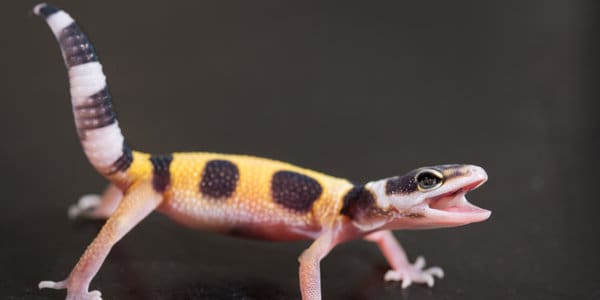
Expenses
The initial terrarium setup with heating and lighting installation is quite pricey. Monthly electricity bills and replacing the UVB bulb every six months are the only extra costs tied to having a bearded dragon. Food costs are generally low, and it costs around $5- 30 per week to feed them, and you can supplement their diet with small crickets.
Leopard geckos don’t require specialized lighting and heating, making the initial terrarium setup much cheaper. However, if the leopard gecko can’t access sunshine, you need to provide a basking bulb with cool-white light.
You also don’t have to provide a sand and calcium sand substrate as it can cause impaction when swallowed. Instead, you can use a reptile carpet or paper towels, which you must replace weekly. The cost of feeding and maintaining a leopard gecko averages $10 per week.
Verdict: Both bearded dragons and leopard geckos are relatively low-cost to maintain. However, the initial terrarium cost might be high, and over time, it’s much cheaper for you to breed your feeder bugs to reduce the food costs.
Ability to Live In Groups
Bearded dragons prefer to live alone, and cohabiting any of the genders will always result in conflicts and injuries. They are aggressively territorial and prefer to live solo lives. Even if you try it, make sure there’s a very large space of at least 125 gallons. This is incredibly big and will obviously increase the costs.
Consider the size before placing them in the same tank. If one is too big, there’s a chance they will bully the smaller ones. A mistake you should not make is to keep two adult bearded dragons together.
Leopard geckos are also territorial and should not be kept together as they will end up fighting. Mixing male Leos is especially a bad idea because there’s a good chance a fight will ensue.
The fights are also likely to disrupt any females sharing the tank enclosure with males. If you do mix them, make sure there’s enough space for them to ensure happiness.
Female leopard geckos can mix together, but you still need to provide enough space. For instance, you should ensure each has at least 10 gallons tank size. As for two leopard geckos, you should at least have 30 gallons.
If you decide to mix male and female Leos, ensure you don’t have more than three females with one male, or the male won’t be able to keep up with the demands. There will be too much breeding, after all.
Verdict: both bearded dragons and leopard geckos should not live in groups unless there’s a very large space
Breeding and Egg-Laying
Female bearded dragons mature after eight to twelve months, but they don’t start breeding until they are two years old and weigh at least 400 grams. They can lay eggs without mating, although they will be infertile.
Leopard geckos become sexually mature at around one year, and they can incubate fertile eggs in 4-5 clutches of two eggs per season. The temperatures during the incubation stage will determine the sex of hatchlings with 80-82°F producing females, 89-90°F making males, and 85°F providing an equal split.
Can a Bearded Dragon Cohabitate with a Leopard Gecko?
Regardless of how much you love these two pets, keeping them together is not advisable. If you do decide to keep both of them, you have to keep them in separate habitats. Making them tank mates is likely to end in disaster.
Habitat Requirements
Bearded dragons are native to Australia’s woodlands and prefer to play outside in the sun. You need a UVB bulb with higher wattage to meet their temperature requirements in captivity. Also, bearded dragons love to sleep quite a lot at night and spend the day feeding on insects and vegetation.
Leopard geckos are different because they come out at night to hunt insects due to their nocturnal nature. They don’t require lighting unless it’s special lighting. However, a heating pad under their belly will keep them happier and healthy.
Precisely, these two species cannot live together because they have different lighting, temperature, and humidity needs. Also, while bearded dragons need a lamp for warmth, Leos like a heating pad for belly heating. It’s also important to note that UVB lights are not recommended for some types of leopard geckos.
Competition
Female bearded dragons and male leopard geckos are incredibly protective. If any other pet coming to their habitat is an intruder. Male beardies are aggressive and will do everything and take every chance to remove an intruder, in this case, the leopard gecko.
Leopard geckos do not have an issue with other pets, but they are extremely territorial. Any intruder will face their wrath. Leopard geckos are nocturnal, so there’s a chance they might attack and kill the bearded dragon in darkness.
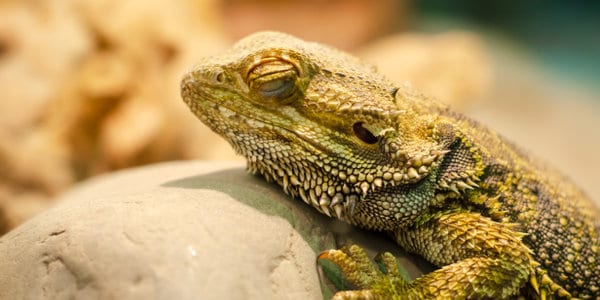
Transmission of Diseases
If the habitat is large enough, there’s little chance that these two animals will meet. Keep in mind that both these reptiles carry parasites, so you might also have a massive parasite problem to deal with should they share the habitat.
A more significant issue is that each pet’s parasite can harm the other. The mode of transmission is through the feces of these reptiles. The leopard gecko will transmit the bacteria, viruses, and parasites to the bearded dragon or vice versa.
Pros and Cons
Bearded Dragons
Bearded dragons are suitable for very young children who want to feel what it is like to care for and love a pet. They are also an excellent option for adults who prefer to keep reptiles as pets.
They are great indoor pets but can be suitable for someone who needs a reptile to enjoy time outdoors in the summer or going for walks.
Pros
- Friendly and enjoy handling
- A great beginner pet reptile
- Requires minimal skin maintenance
- Has unique individual personality
- Has a wide variety of tank materials and substrate alternatives
Cons
- Requires specialized care
- It might require a larger space
- complex diet
- Can mess the food and water
- Exotic vets may not be available nearby for when they fall sick
Leopard Gecko
Leopard geckos are relatively small even when they reach maturity, so you may not worry about their space as much. It’s essential to limit the handling of the gecko because they are relatively shy. It’s an excellent choice for someone who prefers watching to touching.
Pros
- They are docile and friendly
- Great for beginners
- They are fun to watch
- Require limited space
- Tank and flooring options are readily available
Cons
- Requires specialized care
- Close monitoring is needed
- The live insects diet is expensive
- Finding a vet nearby might be difficult
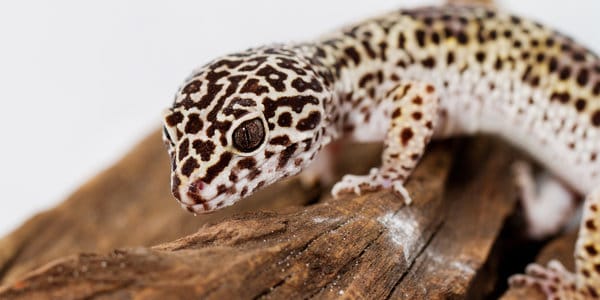
Bearded Dragon Vs. Leopard Gecko, Which One Is Better for Me?
From our comparison above, it’s evident that both species make great pets and that your choice will come down to your preference. Bearded dragons are a great choice for reptile owners with kids due to their unmatched ability to reveal multiple personalities.
On the other hand, Leopard geckos are easy to maintain and require less tank space. However, they are more expensive to maintain compared to the beardies.
Both the bearded dragons and leopard geckos are suitable for beginners, but bearded dragons require more of your time, especially during the first few months.
Bearded dragons tend to be more active during the day, while the geckos are friendlier during the evenings, but they dislike handling.
Regardless of the pet you choose, either of them will make you a proud owner.